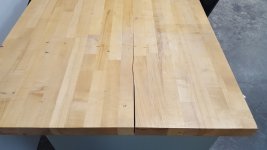I picked up a couple of used workbenches with 30 x 72" butcher-block tops, one with a substantial crack/separation of glue seam and actual wood tearing, pretty much in the middle of the 30" dimension, running into the top from the end, about 15" or so parallel to the length. At the widest part (end of table) it's about 1/8" wide. The interesting part is it doesn't create a wider dimension on that end of the table. It still measures within about .010" of the 30" width. I am "shocked" at how this wood could shrink that much within the bulk of the material, and have such a large crack with essentially no dimensional change on the outside dims.
Anyone have a slick suggestion for fill-in and general repair technique? I tried putting a couple of bar clamps across the end of the table to see if this could be closed up with some glue in place, but it's way too stiff for that to work, IME, so some sort of filler seems to be in order.
Anyone have a slick suggestion for fill-in and general repair technique? I tried putting a couple of bar clamps across the end of the table to see if this could be closed up with some glue in place, but it's way too stiff for that to work, IME, so some sort of filler seems to be in order.



